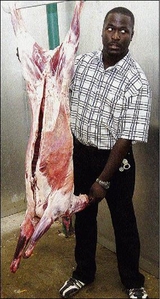Mary had a little lamb ... for dinner!
Published: Thursday | February 5, 2009

Loren Thomas, farm manager at the Longville Park Sheep Farm in Clarendon shows off a lamb that has been slaughtered, skinned, inspected and is ready to be delivered. - Ricardo Makyn/Staff Photographer.
The sheep is the oldest domesticated animal raised by man from as far back as 9,000 years ago. Donnie Bunting, owner of the Clarendon-based Longville Park Sheep Farm and president of the Jamaica Sheep Farmers Association, is carrying on that tradition. The Lifestyle team visited the farm last Friday.
Bunting said that the meat of lambs comes in five different grades: prime, choice, good, utility, and cull and cost $600, $450, $330, $250, $200 per pound respectively. There are also five basic major primal cuts into which lamb meat is separated: leg, shoulder, loin, chops, spare ribs, and shank/breast.
Grades of lamb
The two top-of-the-line grades of lamb meat are prime and choice. What makes a meat prime as opposed to choice, is the genetics of the lamb. However, the prime and choice are not the usual suitable choice for the average Jamaican because they are accustomed to cooking or 'cremating' their meat.
He also points out that Jamaicans are lovers of curried goat and over the years have also come to love curried mutton (sheep meat). But, the prime or choice cuts, which are extremely tender and succulent, are not the grades to be curried. Instead, he explained that the ideal cuts to curry would be utility and cull.
He also explained that many people are not aware that the head and the belly of the sheep can make a scrumptious soup (much like mannish water minus the strong odour).
"It is much like mannish water but differs in taste," said Bunting. He also uses the meat of the lamb to make a very tasty sausage, which he said is quite popular.
Bunting told Food that his primary customers are resorts across the island. However, many of the hotels were at first more interested in rack of lamb which can be very costly. As such, he said he got the resorts to take a whole lamb for roasting.
"What I usually do was go to the various resorts and roast a whole lamb on spot in either jerk or rosemary garlic flavours, then carve it up for them." This he said created a different and more interesting way of serving lamb.
He notes that after a while the hotels caught on and began doing it for themselves.
Bunting said that hotels are used to purchasing meat in bulk, but he takes pride in selling only the best and freshest cuts of meat. Thus, he only slaughters six lambs per week on Tuesdays and Fridays. Lambs are slaughtered, skinned and cleaned then tested by the health inspector before delivery. The meat is left in a cold room for no longer than two to three days.
Lamb is tender if it comes from animals under a year old. However, ageing is also a means of getting the meat tender. In other countries lamb is hung in a chill room under controlled temperature and left for days until it is almost rancid. By then, it has a strong odour.This is not the method used here because Jamaicans are into 'cooking down' their meat, but it is done a lot in England.
Additional source: www.whfoods.com

Donnie Bunting owner of Longville Park Farm in Clarendon makes his point.
Nutritional value
1. Although high in saturated fat, lamb is a very good source of protein, providing 60.3 per cent of the daily requirement of protein.
2. It is also a good source of zinc, a mineral that affects many fundamental processes, perhaps the most important of which is immune function.
3. It is also a good source of vitamin B12. This vitamin supports production of red blood cells and prevents anaemia, allows nerve cells to develop properly, and helps your cells metabolise protein, carbohydrate, and fat.
4. Research published in the August 2004 issue of the Journal of Neurology, Neurosurgery and Psychiatry indicates regular consumption of niacin-rich foods like lamb provides protection against Alzheimer's disease and age-related cognitive decline.
